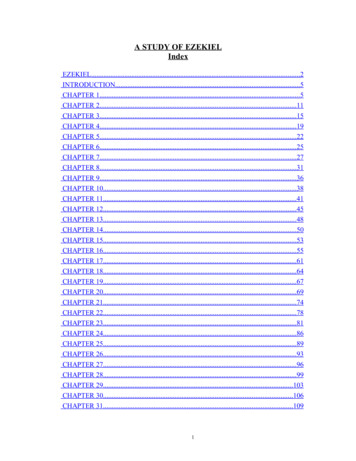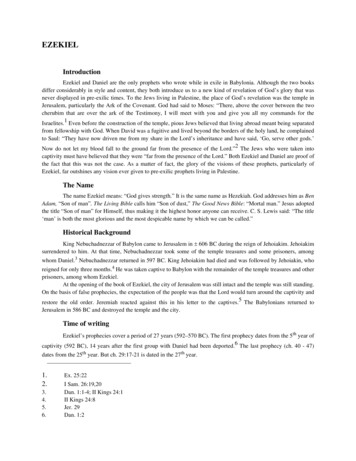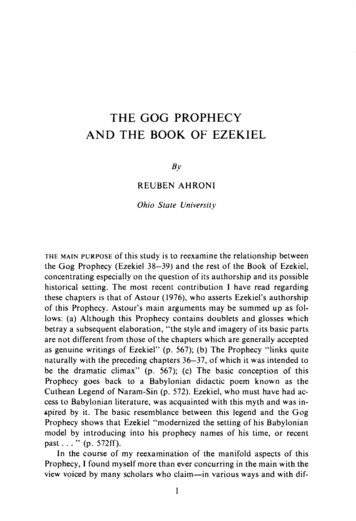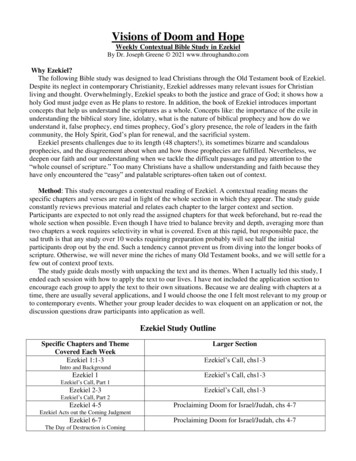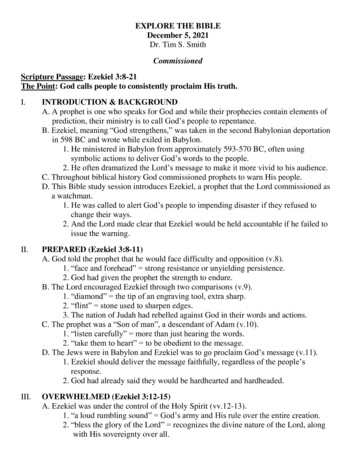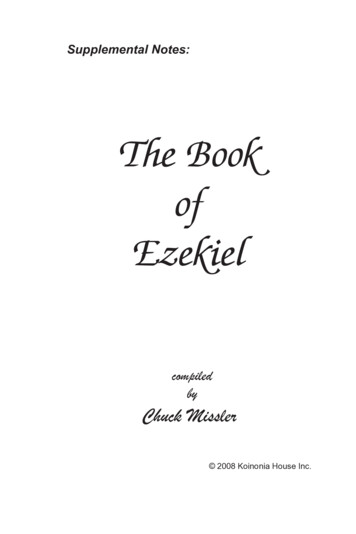
Transcription
Supplemental Notes:The BookofEzekielcompiledbyChuck Missler 2008 Koinonia House Inc.
Audio ListingSession 1: Introduction and Ezekiel Chapter 1Introduction. The Four Living Creatures. The Camp of Israel.Session 2: Ezekiel Chapters 2 - 3Ezekiel’s Call, Preparation, and Office as a Watchman.Session 3: Ezekiel Chapters 4 - 5Siege on Jerusalem. 430 Days. Three Balances.AcknowledgmentsThese notes have been assembled from speaking notes and relatedmaterials which had been compiled from a number of classic and contemporary commentaries and other sources detailed in the bibliography,as well as other articles and publications of Koinonia House. Whilewe have attempted to include relevant endnotes and other references,we apologize for any errors or oversights.The complete recordings of the sessions, as well as supporting diagrams,maps, etc., are also available in various audiovisual formats from thepublisher.Session 4: Ezekiel Chapters 6 - 7Mountains. The End is Come. Idolatry in the Temple.Session 5: Ezekiel Chapters 8 - 11Six Men. Shekinah Glory leaves the Temple.Session 6: Ezekiel Chapters 12 - 13Rebellious House. Zedekiah. Pelatiah is Judged. False Prophets.Session 7: Ezekiel Chapters 14 - 16Judgment. Noah, Daniel and Job. Unfruitful Vine. Parable of Jotham.Session 8: Ezekiel Chapters 17 - 19The Great Eagle. Individual Accountability. Two Lions.Page Page
Audio ListingSession 9: Ezekiel Chapters 19 - 20The History of Rebellion. Idols of Egypt. Scattered Among theNations.Session 10: Ezekiel Chapters 21 - 22The Sword. City of Blood. Smelting Furnace.Session 11: Ezekiel Chapters 23 - 24Two Sisters. Cup of Judgment. The Boiling Pot.Session 12: Ezekiel Chapter 25God’s Judgment on the Muslim Nations: Ammon, Moab, Edom.Session 13: Ezekiel Chapters 26 - 27God’s Judgment on the Muslim Nations: Tyre, Persia, Ophir.Session 14: Ezekiel Chapter 28The Power Behind the Throne. Satan. The Gap Theory.Session 15: Ezekiel Chapters 29 - 31God’s Judgment upon Egypt. The Sword Continues. The Fall of Pharaoh. Egypt and the Aswan Dam.Session 16: Ezekiel Chapter 32Tour of Sheol. The Rise of Islam. 666 and the anti-Christ.Audio ListingSession 17: Ezekiel Chapters 33 - 35The Role of the Watchman. The Wicked Shepherds. Judgment ofEdom.Session 18: Ezekiel Chapters 36 - 37The Restoration of the Land. The Restoration of the Nation . The Vision of the Dry Bones.Session 19: Ezekiel Chapters 38 - 39The Magog Invasion. Nuclear Weapons? Timing Placement.Session 20: Ezekiel Chapters 40 - 42The Vision of the Temple. Which Temple? Angel of the Lord. Zadok.Inner Court.Session 21: Ezekiel Chapters 43 - 45New Worship of God. Return of Glory. Sacrifices.Session 22: Ezekiel Chapters 46 - 48New Appointments of the Land of Israel to the Tribes. Division of theLand. The Sanctuary. The City.Session 23: The Origin of Evil - Part 1The Origin of Evil. When Did Satan Fall?Session 24: The Origin of Evil - Part 2Spiritual Warfare. Armor of God.Page Page
The Book of EzekielSession 1: Introduction and Chapter 1Agenda for Session 1 Historical BackgroundEzekiel the manOrganization of the BookChapter 1: The Vision of God’s ThroneScripture does not have one meaning for you and another for me. Inall these prophecies God had an intended communication. They weregiven to us in the Bible for our learning and enlightenment. Now, theremay be areas in the Scripture where you and I may have different views.However, it is not a selective nor secret knowledge type of thing. Youronly guide is the Holy Spirit.2 Peter 1:21 continues saying, “For the prophecy came not in old timeby the will of man, but holy men of God spoke as they were moved bythe Holy Spirit.” This is very evident in the book we are about to study,Ezekiel. It is probably the most ignored book in the Old Testament.Historical Background: The Two Kingdoms The Northern Kingdom – Israel– 19 Kings reigned 250 years– 7 different dynasties– Assyrian Captivity, 721 b.c. (no return)The Southern Kingdom – Judah– 20 Kings reigned 370 years– 1 dynasty: The Davidic– Babylonian Captivity, 606 b.c. (70 years)Chronology Knowing this first, that no prophecy of the scripture is of any privateinterpretation. For the prophecy came not in old time by the will of man:but holy men of God spake as they were moved by the Holy Ghost.2 Peter 1:20-21 612 b.c.: Nineveh falls to an alliance of Babylon and Media.609 b.c.: Pharaoh Necho leads army against Assyria. Josiah fightsNecho and gets killed (2 Chr 35:20-24).Page 606 b.c.: Battle of Carchemesh. Nebuchadnezzar vs. Pharaoh Nechoon the West bank of Euphrates (Jer 46:1-6).606 b.c.: The Babylonians began the first of three deportations ofthe Jews; Daniel was in this group.597 b.c.: In the second group was young Ezekiel, then about twentyfive years old. He was taken to Tel Aviv near the ship canal Chebar(3:15). There he lived in his own house with his beloved wife (8:1;24:16ff).592 b.c.: Five years after Ezekiel came to Tel Aviv, he was called tobe a prophet of God, when he was 30 years old (this was 6 yearsbefore the destruction of Jerusalem in 586, so while Jeremiahwas ministering to the people back home, Ezekiel was preachingto the Jews of the captivity in Babylon. Like Jeremiah, Ezekiel wasa priest called to be a prophet.Ezekiel the ManEzekiel’s name means “God strengthens, or God will strengthen.”Ezekiel is one of the three that were called the Captivity Prophets (theother two are Jeremiah and Daniel).It was during the eleven-year reign of Jehoiakim that the first deportation took place when Daniel was taken captive. Daniel was a youngman, but also writing at that time. Daniel had been taken into the courtof the king of Babylon and had become his prime minister. Ezekielnever mentions Jeremiah in his writings, but he does mention Danielthree times.Ezekiel was a priest, but he never served in that office because he wastaken captive to Babylon during the second deportation in the reign ofJehoiachin, who was the king of Judah who followed Jehoiakim (2 Kgs24:10–16). Jehoiachin (also called Jeconiah) then came to the throneand reigned only three months. Jehoiachin was the object of the bloodcurse that is circumvented by the virgin birth (Jer 22:30).Jeremiah was an old man at this time. He had begun his ministry as ayoung man during the reign of young King Josiah. He had remained withthe remnant in the land and then was taken by them down into Egypt.Ezekiel was with the captives who had been brought down to the riversof Babylon. The captives had been placed by the great canal that cameoff the River Euphrates, which was several miles from Babylon itself.Ezekiel’s ministry was among those people.Page
The Captivity ProphetsThe Conflict of MessagesJeremiah, Ezekiel, and Daniel each had a particular and peculiar ministryto a certain group of people, and apparently they never came into contactwith each other. From the record in the Book of Daniel you would notgather that Daniel ever visited his people in Babylon where Ezekiel was;yet he had a great concern for them and he actually defended them.Daniel was acquainted with the prophecies of Jeremiah. As a youngman in his teens he may have listened to Jeremiah in Jerusalem. Ezekielalso was a young man when he was taken captive, and he too probablyhad heard Jeremiah.Though the prophet was in distant Babylon, he was able to see eventsin Jerusalem through the power of the Spirit of God. Ezekiel not onlyproclaimed God’s message to the people, but he had to live the messagebefore them. God commanded him to do a number of symbolic acts inorder to get the attention of the people:Strange Similes He shuts himself up in his home.He binds himself.He is struck dumb.He was to lie on his right and his left sides for a total of 430days.He ate bread that was prepared in an unclean manner.He shaved his head and beard, which was considered a shame inhis particular calling.Symbolic Acts Play at warLie on his side a specific number of daysShave his hair and beardAct like someone fleeing from warSit and sighand, the most difficult of all,watch his wife die.It was not easy to be a prophet.Ezek 4:1–3Ezek 4:4–17Ezek 5:1–4Ezek 12:1–16Ezek 21:1–7Ezek 24:15–27Source: Wiersbe, Warren W.: Wiersbe’s Expository Outlines on the Old Testament.Wheaton, IL : Victor Books, 1993.Page Jeremiah had told them to settle down in Babylon for seventy years,but the false prophets told the people that God would destroy Babylonand set the captives free (Jer 28 & 29). It was Ezekiel’s task to tell thepeople that God would destroy Jerusalem, not Babylon, but that therewould one day be a glorious restoration of the people and a rebuildingof the temple.Organization of Ezekiel’s BookHis book may also be divided into three sections, following the prophet’scall in Ezekiel 1–3:Ch.1) God’s judgment on Jerusalem,4-2425-322) God’s judgment on the surrounding nations,3) God’s restoration of the Jews in the kingdom.33-48 The Valley of Dry Bones36-37 Gog and Magog38-39 The Millennium40-48Chapters:1 – 24 were given before the siege of Jerusalem;25 – 32 during the siege;33 – 48 after the siege.Sequencing1) Ezekiel’s call to prophesy (1:1-3:15).2) Symbolical predictions of Jerusalem’s destruction (3:16-7:27).3) 14 months later: a vision of the temple polluted by Tammuz orAdonis worship; God’s consequent scattering of fire over the cityand forsaking of the temple to reveal Himself to an inquiring peoplein exile; and, happier and purer times to follow (8:1-11:25).4) Exposure of the particular sins prevalent in the priests, prophets,and princes (12:1-19:14).5) A year later: the warning of judgment for national guilt repeatedwith greater distinctness as the time drew nearer (20:1-23:49).6) Two years and five months later—the very day on which Ezekielspeaks—the day of the beginning of the siege; Jerusalem shall beoverthrown (24:1-27).7) Predictions against Muslim nations during the interval of silencetowards his own people; if judgment begins at the house of God,much more will it visit the ungodly world (25:1-32:32). Some ofPage
these were uttered much later than others, but they all began to begiven after the fall of Jerusalem.8) In the 12th year of the captivity, when the fugitives from Jerusalemhad appeared in Chaldea (33:21), he foretells better times, thereestablishment of Israel, and the triumph of God’s kingdom onearth over its enemies, Islam, and Gog (33:1-39:29).9) After an interval of 13 years, the closing vision of the restoredkingdom (40:1-48:35).Other Reckonings Source: Jamieson, Robert; Fausset, A. R.; Brown, David, A Commentary, Criticaland Explanatory, on the Old and New Testaments, Logos Research Systems,Inc., Oak Harbor, WA, 1997. Outline of Ezekiel 8The Call of the ProphetGod’s Judgment on Jerusalem(Given before the siege of Jerusalem)God’s Judgment on the Muslim Nations(Given during the siege)The Restoration of the Jews(Given after the siege)They return to their landThey experience new life and unityThey are protected from Gog and MagogThe Millennial KingdomEzekiel 1: The Vision of God’s ThroneThe Chariot of God’s Throne, described by Ezekiel, is a glimpse ofhyperdimensional event. He is not describing an aircraft, UFO, et al.Let the text speak to you—personally. Remember, we live in only four(of 10) dimensions; cf. hypercube unraveled in 3D; et al. There havebeen various speculations, which have given prophetic studies a badname let the text speak to you 1]Now it came to pass in the thirtieth year, in the fourth month, in the fifth day ofthe month, as I was among the captives by the river of Chebar, that the heavenswere opened, and I saw visions of God. 30th year: the year of maturity for a priest (Num 4:3);30th year since Josiah’s revival (Ezekiel was born during Josiah’srevival);Page 10 30th year of Jehoiachin’s age, 585 b.c. (Snaith)30th year after Josiah’s reform, 593/592 b.c. (Targum, Jerome,Hermann, Holscher, L. Finkelstein)30th year of the current jubilee period (Seder Olam, Kimchi,Hitzig)30th year of the neo-Babylonian empire, 606/605 b.c. (Scaliger,Ewald)30th year of Manasseh, 667 b.c. (Torrey)30th year of Nebuchadnezzar’s reign, 592 b.c. (Rothstein, Bertholet);fifth year of Jehoiachin’s exile, 595/594 b.c. (Herntrich)30th year of the editing of Ezekiel’s book, three years after the twenty-seventh year of 29:17, or 567 b.c. and the 30th year ofJehoiachin’s reign. (Albright and Howie) Cf 2 Kgs 25:27All the other dates in the prophecy are reckoned from Jehoiachin’s“reign” or captivity,Source: Pfeiffer, Charles F., The Wycliffe Bible Commentary: Old Testament, MoodyPress, Chicago, IL, 1962.“.in the fourth month, in the fifth day of the month.” This was notquite the time of the destruction of Jerusalem that took place during thereign of Zedekiah, which followed.that the heavens were opened, and I saw visions of God”: Contrastwith the depression of the captives (Ps 137:1,2); cf. Visions of Isaiah(Isa 6) and the visions of John (Rev 4 & 5).2]In the fifth day of the month, which was the fifth year of king Jehoiachin’scaptivity,King JehoiachinThe 18th, and next to the last, king of Judah, was the son of the pettytyrant, Jehoiakim, and grandson of the godly Josiah. His name, meaning“The Lord establishes.”Enthroned by Pharaoh Necho of Egypt, he reigned only three monthswhen he was deported to Babylon by Nebuchadnezzar in the year 597b.c., along with the upper classes (2 Kgs 24:8-16). He was released byAmel Marduk (Evil Merodach), son of Nebuchadnezzar in 560 b.c., the37th year of his exile (2 Kgs 25:27). [“The Jehoiachin tablets,” publishedin 1939, refer to “Yaukin” and his sons as receiving rations (Albright,Biblical Archaeologist, V (Dec. 1942), pp. 49-55).]Page 11
The fifth year of king Jehoiachin’s captivity (June-July, 592 b.c.) is thefirst of 14 date references in the book of Ezekiel (cf. 1:2; 3:16; 8:1; 20:1;24:1; 26:1; 29:1; 29:17; 30:20; 31:1; 32:1; 32:17; 33:21; 40:1).3]5]“ .four living creatures”: Cherubim (Cf. Ezek 10:15,20).The word of the LORD came expressly unto Ezekiel the priest, theson of Buzi, in the land of the Chaldeans by the river Chebar; andthe hand of the LORD was there upon him.“Likeness of a man.”: similar, not identical with (Cf. v.26); not atautology: “Likeness” expresses the general form; “appearance,” aparticular aspect.Chebar was the main canal that came off the Euphrates River, whichwatered that area. This area was removed by quite a few miles from Babylon Evidently, the Jewish captives were put there to till the land. tWmD demuth “likeness” used 10 times; ha,r m; mareh “appearance” used 14 times.The River Chebar“The great river,” “the grand canal,” the River Chebar was an artificialwatercourse of the Euphrates. Beginning above Babylon, it flowed southeast, passed through Nippur, site of ancient Jewish settlements (and ofthe wealthy banking house of Murashu and Sons, whose archives from464-405 b.c. contain many Jewish names), and joined the Euphrates againbelow Ur. This area was removed by quite a few miles from Babylonand, evidently, the Jewish captives were put there to till the land.Ezekiel’s home was on the river Chebar, at Tel-aviv, the principal colonyof the exiles, near the city of Nippur, southeast of BabylonThe prophet senses the inadequacy of human speech to describe theineffable.SuperAngels 6]And I looked, and, behold, a whirlwind came out of the north, a great cloud,and a fire infolding itself, and a brightness was about it, and out of the midstthereof as the colour of amber, out of the midst of the fire.7]“.out of the north”: Used in Scripture to point toward the throne ofGod (Isa 14:13; Ps 75:5-7).9]“.a fire infolding itself, and a brightness was about it, and out of themidst thereof as the colour of amber, out of the midst of the fire.” “Our God is a consuming fire”“God is light ”Hebrews 12:291 John 1:5Paul, at the time of his conversion, saw “a light from heaven, abovethe brightness of the sun ” (Acts 26:13).Page 12 ybirUK. Cherubim (4 wings): Seen guarding the Tree of Life (Gen3:24) and adorning the Mercy Seat, et al. (Ex 25:10-22). ypirf” . Seraphim (6 wings): Vision of the Throne of God (Isa 6:2).zw/ on zoon Living Creatures (6 wings): Vision of the Throne ofGod (Rev 4,5).(Polymorphic?)HaSatan was the “anointed cherub that covereth” (Ezek 28:14).And every one had four faces, and every one had four wings.The four faces are subsequently described in v.10.“.the hand of the LORD was there upon him”: Note phrase usage 4]Also out of the midst thereof came the likeness of four living creatures. Andthis was their appearance; they had the likeness of a man.8]And their feet were straight feet; and the sole of their feet was like the sole ofa calf’s foot: and they sparkled like the colour of burnished brass.And they had the hands of a man under their wings on their four sides; and theyfour had their faces and their wings.Their wings were joined one to another; they turned not when they went; theywent every one straight forward.These creatures symbolize the glory and power of God.“.straight forward”: “No variableness or turning” (James 1:17). [Parallax: focus at infinity.] They could see in all directions and move in alldirections without turning.10] As for the likeness of their faces, they four had the face of a man, and the faceof a lion, on the right side: and they four had the face of an ox on the left side;they four also had the face of an eagle.Page 13
Vision of the Throne of God:Ezekiel 1 & 10 (Cf. Isaiah 6, Revelation 4)Rabbinical PrecisionThe Camp of Judah was located East of Levites. The Camp of Reuben,South of Levites. Strict obedience denies camping in the area Southeast;thus, only cardinal directions ordained—only the width of Levite’s campwas allowed, with each camp’s length proportional to population.The Camp of Israel: Numbers 2Is every detail in the Bible there by Design? What might be hiddenbehind the details of the Camp of Israel? “The volume of the Book iswritten of Me” (Ps 40:7; Heb phtali62,70041,50053,400157,600Page 14[*Ahiezer changes the serpent (Gen 49: ) for an eagle (with a serpent in its mouth):Merrill F. Unger, Unger’s Bible Dictionary, Moody Press, Chicago, 1966,pp.235-236.]Page 15
“beryl”: ancient chrysolite (goldstone), probably corresponding to ourgold-colored topaz.“.a wheel in the middle of a wheel”: Orthogonal, not concentric; probably hyperdimensional (more than 3-D).Wheels? Cf the wheels of the throne of “the Ancient of days” (Dan 7:9);Cf. the bases in Solomon’s Temple, (1 Kgs 7:27-30);Cf. the chariot in 1 Chr 28:18.17] When they went, they went upon their four sides: and they turned not whenthey went.11] Thus were their faces: and their wings were stretched upward; two wings ofevery one were joined one to another, and two covered their bodies.12] And they went every one straight forward: whither the spirit was to go, theywent; and they turned not when they went.God is moving forward undeviatingly, unhesitatingly toward the accomplishment of His purpose in this world today. Nothing will deterHim—nothing can sidetrack Him at all.13] As for the likeness of the living creatures, their appearance was like burning coalsof fire, and like the appearance of lamps: it went up and down among the livingcreatures; and the fire was bright, and out of the fire went forth lightning.“.appearance of lamps”: “God is light ” (1 Jn 1:5); “I am the lightof the world ” (Jn 8:12); “But if we walk in the light, as he is in thelight, we have fellowship one with another, and the blood of Jesus Christhis Son cleanseth us from all sin” (1 Jn 1:7).14] And the living creatures ran and returned as the appearance of a flash of lightning.15] Now as I beheld the living creatures, behold one wheel upon the earth by theliving creatures, with his four faces.16] The appearance of the wheels and their work was like unto the colour of a beryl:and they four had one likeness: and their appearance and their work was as itwere a wheel in the middle of a wheel.Page 16God is a God of intelligent purpose. You and I are not living in a universe that is moving into the future aimlessly and without purpose:randomness does not exist in nature. God has a purpose for every atomwhich he has created, and he has a purpose for you. The very fact thatyou and I are alive today reveals that we are to accomplish a purposefor God (Jer 29:11).18] As for their rings, they were so high that they were dreadful; and their ringswere full of eyes round about them four.They were “full of eyes” (Prov 15:3), picturing the omniscience of God asHe rules His creation, and the movements of the wheels and the cherubimcongruent. All of this speaks of God’s constant working in the world,His power and glory, His purpose for man, and His providence.19] And when the living creatures went, the wheels went by them: and when theliving creatures were lifted up from the earth, the wheels were lifted up.These wheels seem to speak of the ceaseless activity and energy of God.20] Whithersoever the spirit was to go, they went, thither was their spirit to go; andthe wheels were lifted up over against them: for the spirit of the living creaturewas in the wheels.These four living creatures are guard the throne of God (Rev 4):1) They protect the throne in that they do not allow man in his sinto come into the presence of God; and2) They indicate the way that man is to come.Page 17
21] When those went, these went; and when those stood, these stood; and whenthose were lifted up from the earth, the wheels were lifted up over against them:for the spirit of the living creature was in the wheels.22] And the likeness of the firmament upon the heads of the living creature was asthe colour of the terrible crystal, stretched forth over their heads above.Word was made flesh, and dwelt [pitched His tent] among us ” (Jn1:14); “How beautiful upon the mountains are the feet of him thatbringeth good tidings, that publisheth peace; that bringeth good tidings of good, that publisheth salvation; that saith unto Zion, Thy Godreigneth!” (Isa 52:7).“.firmament”: [;yqir’ raqia (a solid expanse): occurs 17 times in theScriptures (Gen 1; Ezek 1; 10:1; Ps 19:1; 150:1; Dan 12:3). This wasa beautiful “platform” above the wheels and the cherubim, containingthe throne of God.27] And I saw as the colour of amber, as the appearance of fire round about withinit, from the appearance of his loins even upward, and from the appearance ofhis loins even downward, I saw as it were the appearance of fire, and it hadbrightness round about.23] And under the firmament were their wings straight, the one toward the other:every one had two, which covered on this side, and every one had two, whichcovered on that side, their bodies.The upper part of the human likeness seated on the throne shown likegleaming bronze which fire enclosed round about while the lower part,also, was covered by a fiery brightnessGod is still on the throne, and His will is being accomplished in thisworld even if we do not see it. The complex movements of the cherubimand the wheels reveal how intricate is God’s providence in the universe:perfect harmony and order.28] As the appearance of the bow that is in the cloud in the day of rain, so wasthe appearance of the brightness round about. This was the appearance of thelikeness of the glory of the LORD. And when I saw it, I fell upon my face, andI heard a voice of one that spake.24] And when they went, I heard the noise of their wings, like the noise of greatwaters, as the voice of the Almighty, the voice of speech, as the noise of anhost: when they stood, they let down their wings.“.voice of the Almighty”: Cf. Seven thunders? (Ps 29; Rev 10:3,4).Sounds “like the noise of great waters” (Ps 42:7; Isa 17:12).“like the thunder of the Almighty”, “voice of God,” seven times(Ps 29).“a sound of tumult like the sound of a host” (Isa 17:12; Joel 2:5).“Almighty” yD;v; Shaddai is a pre-Mosaic term for God, used chieflyin poetry, or in prose prefixed with El (God) Gen 17:1.25] And there was a voice from the firmament that was over their heads, when theystood, and had let down their wings.26] And above the firmament that was over their heads was the likeness of a throne,as the appearance of a sapphire stone: and upon the likeness of the throne wasthe likeness as the appearance of a man above upon it.In the presence of the Lord, this man found himself horizontal withthe ground. Throughout the Old Testament when men came into thepresence of God, they went down on their faces: “Woe is me! for I amundone; because I am a man of unclean lips, and I dwell in the midst ofa people of unclean lips: for mine eyes have seen the King, the Lord ofhosts” ( Isa 6:5). That was the position Daniel took also (Dan 10:6-8)and it was the position John took on the isle of Patmos: “And when Isaw him, I fell at his feet as dead ” (Rev 1:17).The result of this vision was total collapse on the part of Ezekiel. ButGod set him up on his feet, called him to be a watchman, fed him withthe Word, and filled him with the Spirit (Jer 15:16; Job 23:12; Mt 4:4;Rev 10:9).“They shall know that I am the Lord”: This phrase is found 70 timesin this book; it summarizes the ministry and message of Ezekiel.The Glory’s Impact“Sapphire”: This may be the ancient marble-like, azure stone knownas lapis lazuli. “.appearance of a man”: God came to earth a Man, walked the dustytrails of Palestine, until spikes were driven into His feet “And the Page 18Gave him a message at Tel-aviv (Ezek 3:12ff, 22ff).Transported him from his home in the exile to the entrance of thegateway of the inner court of the Temple in Jerusalem (Ezek 8:4,5).Departed from the cherubim in the Temple to the threshold of theTemple (Ezek 9:3; 10:4).Page 19
Mounted up from the threshold to the eastern gate of the Temple’souter court (Ezek 10:15,16,18,19).Went up from the midst of the city to the Mount of Olives on theeast side of the city (Ezek 11:22, 23).But returned to fill the new Temple and cleansed the people (Ezek43:2-7; 44:4).Next Session“Son of d’a‘ Adam”: “son of the dust.” Daniel, also, is called the sonof man (2X). Only these two men in the Old Testament were calledby this title. This is also the title that the Lord Jesus appropriated toHimself—eighty-six times in the New Testament (of His humanity, asthe representative of Man).“.stand ”: Ezekiel clearly had been overwhelmed!2]Re-read Chapter 1 and reflect on what it means to you personally. ReadChapters 2 & 3.The Book of Ezekiel Session 2Chapters 2 & 3“.the spirit entered into me”: In Old Testament times the Holy Spiritdid not indwell all believers but indwelt selected persons temporarilyfor divine service (Ex 31:1-11; 1 Sam 10:9-11; Ps 51:11; Ezek 3:24).3]The Babylonian captivity actually took place in three sieges, but it hadbeen extensively prophesied well in advance (Isa 29:5-7; Jer 25:8-12).Daniel, who had been taken captive as a teenager in the first of thethree sieges, came to know from reading the Jeremiah prophecy thatthe captivity would last for 70 years. That is when he went into prayerwhich was interrupted by Gabriel and the famous 70 week vision ofDaniel 9.The Call of the ProphetGod’s Judgment on Jerusalem(Given before the siege of Jerusalem)God’s Judgment on the Muslim Nations(Given during the siege)The Restoration of the Jews(Given after the siege)They return to their landThey experience new life and unityThey are protected from Gog and MagogThe Millennial KingdomEzekiel 2: The Call of the Prophet1]And he said unto me, Son of man, stand upon thy feet, and I will speak untothee.Page 20And he said unto me, Son of man, I send thee to the children of Israel, to arebellious nation that hath rebelled against me: they and their fathers havetransgressed against me, even unto this very day.“.rebellious nation”: A frequent term in Ezekiel: used 7X in 10verses; 17X in total (Ezek 2:5-6, 8; 3:9, 26-27; 12:3, 9, 25; 17:12;24:3; 44:6).“nation” yAG goi (not normally used of Israel! Israel is usually contrastedwith the “nations”). They were now become “Lo-ammi,” not the peopleof God (Hos 1:9).Outline of 940–48And the spirit entered into me when he spake unto me, and set me upon myfeet, that I heard him that spake unto me.Why 70 Years?2 Chronicles tells us that is why they were enslaved in Babylon forexactly 70 years (2 Chr 36:21): They were supposed to keep (till) theground for six years; the seventh year was to be a Sabbath for the land.They failed to not keep that (Lev 25). So after 490 years, God said,“You owe me 70.”It was to make up for those years when they had violated His laws withrespect to the land. He took the land away from them for 70 years. (Moreon this in Chapter 4). This becomes particularly heavy when you realizethat they had been sent prophet after prophet after prophet to get themto repent, and they did not repent.4]For they are impudent children and stiffhearted. I do send thee unto them; andthou shalt say unto them, Thus saith the Lord GOD.Page 21
“I do send unto them”: When God calls, He empowers.Scrolls “written on both the inside and the outside”: There are only twoscrolls described this way in Scripture: One is given to Ezekiel to “eat” (Ezek 3:1); The other is the Seven Sealed Scroll, which also brings judgment(Rev 5).“.LORD God”: An unusual feature of Ezekiel is the occurrence ofthe two-fold name LORD God, hAihy yn”doa] Adonai Yahweh, 217X vs.103X elsewhere in OT. Adonai YHWH stresses both God’s sovereignauthority and His covenant-keeping faithfulness.“.lamentations, mourning, and woe”: This accurately summarizes thecontents of Ezekiel 4-32. It does not, however, reflect the latter partof the book, in which the prophet spoke of Israel’s restoration. Thiscould explain why Ezekiel was recommissione
Session 14: Ezekiel Chapter 28 The Power Behind the Throne. Satan. The Gap Theory. Session 15: Ezekiel Chapters 29 - 31 God’s Judgment upon Egypt. The Sword Continues. The Fall of Pha-raoh. Egypt and the Aswan Dam. Session 16: Ezekiel Chapter 32 Tour of Sheol. The Rise of Islam. 666 and the anti-Chris
